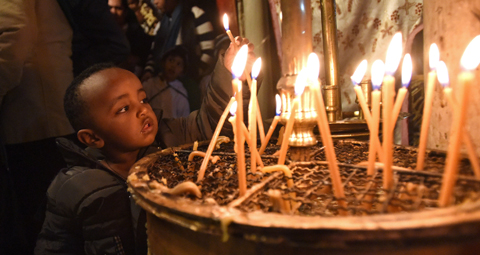December 27 | ![]() 0 COMMENTS
0 COMMENTS ![]() print
print

Shining a light on Christmas tradition
Brandon McGinley sees the beating heart of Faith behind the seasonal commercialism.
I love candlelight at Christmastime. This hardly makes me unique, and indeed this preference is formed by decades of marketing that have created the definitive Christmas aesthetic: crackling hearths and swooping pine boughs and glistening tinsel and, yes, twinkling candlelight.
But this is now our culture’s tradition of Christmas, and it is a real and beautiful and reasonably old one, even if not as ancient and organic as we’d like to imagine.
The modern Christmas, incorporating regional traditions of food and décor with a seasonal humanitarianism and more and more elaborate gift exchange, is rooted in 19th century writers’ attempts to create a holiday that transcended religious controversies and fostered timeless virtues.
More staid Christian cultures still took a while to adopt the new Christmas: For instance Scotland, under the influence of Calvinism, only codified the holy day as a public holiday in the 1950s.
These Protestant communities rejected Christmas (and the Catholic Church) as pagan infiltration.
They weren’t wrong in identifying pagan influences in Christmas celebrations but they got the order of appropriation wrong: the Church wasn’t co-opted by pagans, but pagan traditions by the Church.
This is the way the Church proceeds when she proclaims Christ with confidence.
She doesn’t try to accommodate herself to the prevailing order, and doesn’t try to carve out a niche for herself within that order.
Rather, she transforms the world around her by taking what is worthy in art and custom, then elevating and transforming them to glorify Christ.
God’s grace
This is exactly how God’s grace elevates and transforms our natural abilities to allow us to grow not just in knowledge but in wisdom, not just in courtesy but in sanctity, not just in relationship with our fellow man but in relationship with Him.
We might say now the process has been reversed. Christmas traditions Christians have amalgamated over the years as part of evangelising the world are now being packaged and sold back to us as part of secularising it.
Rather than taking the profane and making it sacred, we take the sacred and make it profane—not necessarily in the sense that we make it vulgar or illicit, but in the sense that we commodify it and make it consumable.
Mediums of sacredness
But we can go too far in our cynicism. We must remember many of the Christmas traditions we cherish do have Christian roots. A Church confident in Christ will try to recapture what is hers and transform what she can into new mediums of sacredness.
This brings me back to candlelight. Celebrations of light were part of various pagan solstice festivals, but the symbolism of light-amid-darkness had obvious applications to the birth of Christ and so Christian communities quite naturally adopted it.
Now we tend to be drawn to Christmas candlelight not in anticipation of what is to come but as a reminder of (what we like to think was) a simpler, more wholesome past.
Even if the world of Christmas past wasn’t quite as innocent as we hoped, there’s still something stirring about the primitiveness of candlelight.
Nothing else seems quite as appropriate to illuminate a Crucifix, an icon, a portrait or Our Lady, or a saint statue.
The trembling light reminds us of the quivering awe we should feel before such sacred images, and the timelessness of fire connects us with Christians over scores of generations.
On December evenings we love to keep our living room lit mostly by short-lived tea lights—well out of reach of more impulsive children.
When I look at those candles, it makes it easier to think of Christmas not as a consumer phenomenon, with the name of Christ splashed across billboards and online disclaimers about which gizmos and doodads will arrive by Christ’s Mass.
Whether there was a moment in the past when it was that simple is irrelevant. In this candlelit moment, right now, it is that simple.
And then in the harsher light of day I go back to ordering gifts and planning parties and addressing cards.
Those twinkling intimations of Heaven can’t last. But we need them to remind us of what does endure forever.










